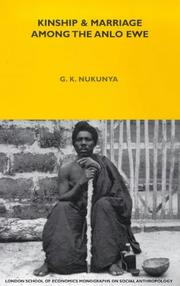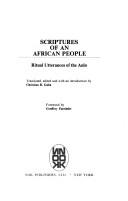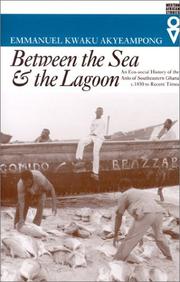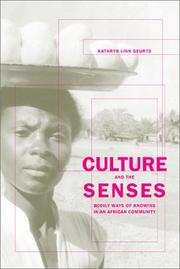| Listing 1 - 10 of 12 | << page >> |
Sort by
|
Book
Year: 1966 Publisher: Paris : Groupe de chercheurs africanistes,
Abstract | Keywords | Export | Availability | Bookmark
 Loading...
Loading...Choose an application
- Reference Manager
- EndNote
- RefWorks (Direct export to RefWorks)

ISBN: 0485196379 9780485196375 Year: 1999 Publisher: London: Athlone,
Abstract | Keywords | Export | Availability | Bookmark
 Loading...
Loading...Choose an application
- Reference Manager
- EndNote
- RefWorks (Direct export to RefWorks)
Anlo (African people) --- Kinship --- Marriage customs and rites --- Kinship. --- Marriage customs and rites. --- Togo
Book
ISBN: 129956285X 0807055190 Year: 2005 Publisher: Boston : Beacon Press,
Abstract | Keywords | Export | Availability | Bookmark
 Loading...
Loading...Choose an application
- Reference Manager
- EndNote
- RefWorks (Direct export to RefWorks)
Slave trade --- Slave trade --- Slave trade --- Anlo (African people) --- History. --- History. --- History. --- Social conditions.

ISBN: 0883570181 Year: 1973 Publisher: New York NOK
Abstract | Keywords | Export | Availability | Bookmark
 Loading...
Loading...Choose an application
- Reference Manager
- EndNote
- RefWorks (Direct export to RefWorks)
Anlo (African people) --- Rites and ceremonies. --- Ahonlan (African people) --- Anglo (African people) --- Ethnology --- Ewe (African people) --- Rites and ceremonies
Book
Year: 1969 Publisher: London : Athlone press,
Abstract | Keywords | Export | Availability | Bookmark
 Loading...
Loading...Choose an application
- Reference Manager
- EndNote
- RefWorks (Direct export to RefWorks)
Anlo (African people) --- Kinship --- Marriage customs and rites --- Marriage customs and rites. --- Kinship. --- Togo --- Social life and customs.

ISBN: 0821414089 0821414097 Year: 2001 Publisher: Athens Ohio university press
Abstract | Keywords | Export | Availability | Bookmark
 Loading...
Loading...Choose an application
- Reference Manager
- EndNote
- RefWorks (Direct export to RefWorks)
Anlo (African people) --- Beach erosion --- Coastal ecology --- Human ecology --- Economic conditions --- Fishing --- Social conditions --- Keta Region (Ghana) --- Environmental conditions.

ISBN: 0520234561 0520234553 9780520234567 Year: 2002 Volume: 3 Publisher: Berkeley : University of California Press,
Abstract | Keywords | Export | Availability | Bookmark
 Loading...
Loading...Choose an application
- Reference Manager
- EndNote
- RefWorks (Direct export to RefWorks)
Adding her stimulating and finely framed ethnography to recent work in the anthropology of the senses, Kathryn Geurts investigates the cultural meaning system and resulting sensorium of Anlo-Ewe-speaking people in southeastern Ghana. Geurts discovered that the five-senses model has little relevance in Anlo culture, where balance is a sense, and balancing (in a physical and psychological sense as well as in literal and metaphorical ways) is an essential component of what it means to be human. Much of perception falls into an Anlo category of 'seselelame '(literally feel-feel-at-flesh-inside), in which what might be considered sensory input, including the Western sixth-sense notion of "intuition," comes from bodily feeling and the interior milieu. The kind of mind-body dichotomy that pervades Western European-Anglo American cultural traditions and philosophical thought is absent. Geurts relates how Anlo society privileges and elaborates what we would call kinesthesia, which most Americans would not even identify as a sense. After this nuanced exploration of an Anlo-Ewe theory of inner states and their way of delineating external experience, readers will never again take for granted the "naturalness" of sight, touch, taste, hearing, and smell.
#SBIB:39A9 --- #SBIB:39A73 --- Medische antropologie / gezondheid / handicaps --- Etnografie: Afrika --- Anlo (African people) --- Senses and sensation --- Psychology. --- Socialization. --- Anlo (African people). --- Anlo (African people)-- Psychology. --- Cross-cultural studies. --- Senses and sensation. --- Senses and sensation - Cross-cultural studies. --- History & Archaeology --- Regions & Countries - Africa --- Ethnology --- Sensation --- Sensory biology --- Sensory systems --- Ahonlan (African people) --- Anglo (African people) --- Psychology --- Socialization --- Knowledge, Theory of --- Neurophysiology --- Psychophysiology --- Perception --- Ewe (African people)
Book
ISBN: 9780852556221 Year: 1996 Publisher: Portsmouth : Heinemann,
Abstract | Keywords | Export | Availability | Bookmark
 Loading...
Loading...Choose an application
- Reference Manager
- EndNote
- RefWorks (Direct export to RefWorks)
Sandra Greene argues convincingly that gender and ethnicity in precolonial Africa can only be understood together. Her book focuses on the history of the Anlo-Ewe of southeastern Ghana over three centuries and demonstrates that the very factors that affected social constructions of gender also had profound implications for the construction of ethnic identities. Greene documents the changes that occurred in ethnic boundaries as the community absorbed refugees, traders, and conquerors and later began to redefine the boundaries between insiders and outsiders. She then analyzes the way shifting ethnic definitions and competition for scarce resources affected gender relations. Clan elders increasingly sacrificed the interests of the young women under their authority in marital arrangements because of an increasing preference for clan endogamy. Greene explores the way some of these women were able to reassert their voices through membership in influential "outsider" religious orders. These new alignments formed a base of support from which Anlo women and a number of ethnic outsiders successfully challenged their own marginalization. Thus by the end of the nineteenth century, the boundary that separated insiders and outsiders in Anlo society and the ways in which men and women interacted had changed significantly. Greene eschews simplistic analyses of oppression and agency. All in Anlo society are given a voice and allowed to speak from their own perspective, establishing a new and exciting standard for analyzing the history of social relations in precolonial Africa.
Anlo (African people) --- Anlo (peuple d'Afrique) --- Anlo (volk). --- Ethnic groups --- Etnische betrekkingen. --- Ewe (African people) --- Ewe (volk). --- Ewé (peuple d'Afrique) --- Geschlechterrolle. --- Ghana. --- Relations interethniques --- Rôle selon le sexe --- Sekserol. --- Sex role --- Sociale verandering. --- Sozialer Wandel. --- Éwé (peuple d'Afrique) --- Social conditions. --- Conditions sociales. --- Social life. --- Ahlŏ. --- Ewe. --- Ghana --- Ethnic relations. --- Relations interethniques.

ISBN: 1282762729 9786612762727 1597345644 052093654X 9780520936546 9780520234550 0520234553 9780520234567 0520234561 0520234553 0520234561 0585466297 9780585466293 9781282762725 9781597345644 Year: 2002 Publisher: Berkeley University of California Press
Abstract | Keywords | Export | Availability | Bookmark
 Loading...
Loading...Choose an application
- Reference Manager
- EndNote
- RefWorks (Direct export to RefWorks)
Adding her stimulating and finely framed ethnography to recent work in the anthropology of the senses, Kathryn Geurts investigates the cultural meaning system and resulting sensorium of Anlo-Ewe-speaking people in southeastern Ghana. Geurts discovered that the five-senses model has little relevance in Anlo culture, where balance is a sense, and balancing (in a physical and psychological sense as well as in literal and metaphorical ways) is an essential component of what it means to be human. Much of perception falls into an Anlo category of seselelame (literally feel-feel-at-flesh-inside), in which what might be considered sensory input, including the Western sixth-sense notion of "intuition," comes from bodily feeling and the interior milieu. The kind of mind-body dichotomy that pervades Western European-Anglo American cultural traditions and philosophical thought is absent. Geurts relates how Anlo society privileges and elaborates what we would call kinesthesia, which most Americans would not even identify as a sense. After this nuanced exploration of an Anlo-Ewe theory of inner states and their way of delineating external experience, readers will never again take for granted the "naturalness" of sight, touch, taste, hearing, and smell.
Senses and sensation --- Anlo (African people) --- Sensation --- Sensory biology --- Sensory systems --- Knowledge, Theory of --- Neurophysiology --- Psychophysiology --- Perception --- Ahonlan (African people) --- Anglo (African people) --- Ethnology --- Ewe (African people) --- Socialization. --- Psychology. --- africa. --- african community. --- anlo culture. --- anlo ewe. --- anlo society. --- anthropologists. --- balance. --- cultural anthropology. --- cultural knowledge. --- cultural meaning. --- cultural perspective. --- cultural traditions. --- demographic studies. --- ethnographers. --- ethnography. --- ghana. --- hearing. --- innate senses. --- inner states. --- metaphorical senses. --- nonfiction. --- perception. --- philosophy. --- physical senses. --- sensorium. --- sensory perception. --- sight. --- smell. --- social cultural. --- social science. --- taste. --- touch.

ISBN: 9786612062735 1282062735 0253108896 9780253108890 9781282062733 6612062738 025334073X 9780253340733 025321517X 9780253215178 Year: 2002 Publisher: Bloomington Indiana University Press
Abstract | Keywords | Export | Availability | Bookmark
 Loading...
Loading...Choose an application
- Reference Manager
- EndNote
- RefWorks (Direct export to RefWorks)
"Greene gives the reader a vivid sense of the Anlo encounter with western thought and Christian beliefs... and the resulting erasures, transferences, adaptations, and alterations in their perceptions of place, space, and the body." -- Emmanuel Akyeampong Sandra E. Greene reconstructs a vivid and convincing portrait of the human and physical environment of the 19th-century Anlo-Ewe people of Ghana and brings history and memory into contemporary context. Drawing on her extensive fieldwork, early European accounts, and missionary archives and publications, Greene shows how ideas from outside forced sacred and spiritual meanings associated with particular bodies of water, burial sites, sacred towns, and the human body itself to change in favor of more scientific and regulatory views. Anlo responses to these colonial ideas involved considerable resistance, and, over time, the Anlo began to attribute selective, varied, and often contradictory meanings to the body and the spaces they inhabited. Despite these multiple meanings, Greene shows that the Anlo were successful in forging a consensus on how to manage their identity, environment, and community.
Human body --- Sacred space --- Anlo (African people) --- Body, Human --- Human beings --- Body image --- Human anatomy --- Human physiology --- Mind and body --- Holy places --- Places, Sacred --- Sacred places --- Sacred sites --- Sacred spaces --- Sites, Sacred --- Space, Sacred --- Holy, The --- Religion and geography --- Ahonlan (African people) --- Anglo (African people) --- Ethnology --- Ewe (African people) --- Social aspects --- Cultural assimilation. --- Religion. --- Ghana --- Chia-na --- Dēmokratia tēs Gkanas --- Gáana --- Gana --- Gana ka Fasojamana --- Gana Konghwaguk --- Gana Respublikaḣy --- Ganæ --- Ganah --- Ganao --- Ganmudin Orn --- Ghana Vabariik --- Ghanako Errepublika --- Ghaney --- Ghanská republika --- Gkana --- Government of Ghana --- Gweriniaeth Ghana --- Hana (Ghana) --- IGana --- Ochíchìíwú Ghana --- Pobblaght ny Ganey --- Poblachd Ghàna --- Poblacht Ghána --- Qana --- Qana Respublikası --- Repubblica del Ghana --- Republic of Ghana --- República de Ghana --- Rèpublica du Gana --- Republik Ghana --- Republika Gana --- Republiḳat Ganah --- République du Ghana --- Rėspublika Hana --- Respublikæ Ganæ --- Tjóðveldið Gana --- Yn Ghaney --- Γκάνα --- Δημοκρατία της Γκάνας --- Рэспубліка Гана --- Республикæ Ганæ --- Република Гана --- Ганæ --- Гана --- Ганмудин Орн --- רפובליקת גאנה --- גאנה --- ガーナ --- 가나 --- 가나 공화국 --- Ashanti --- Gold Coast --- Northern Territories of the Gold Coast --- Togoland (British) --- Colonial influence. --- #SBIB:39A73 --- Cultural assimilation --- Religion --- Etnografie: Afrika --- Anlo (Peuple d'Afrique) --- Lieux sacrés --- Corps humain --- Acculturation --- Aspect social --- Influence coloniale --- Anlo (african people) --- Anlo (volk). --- History. --- Heilige plaatsen. --- Sacred space. --- Social aspects. --- Ewe. --- Ghana.
| Listing 1 - 10 of 12 | << page >> |
Sort by
|

 Search
Search Feedback
Feedback About UniCat
About UniCat  Help
Help News
News